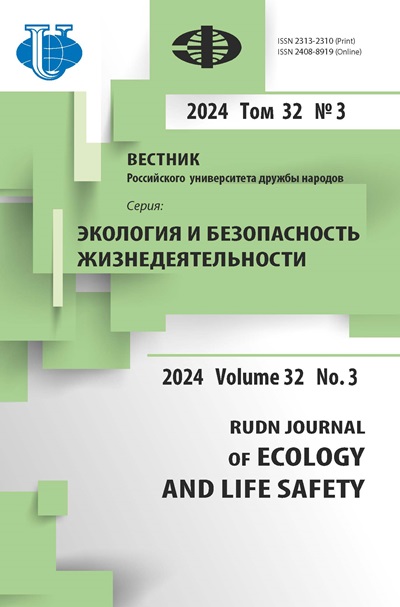Разнообразие и численность копепод на северном побережье Анголы в жаркий сезон 2014-2016 гг.
- Авторы: Кастро И.Ж.1, Коэльо П.А.2, Ванисова Е.А.1
-
Учреждения:
- Российский университет дружбы народов
- Национальный институт рыбного хозяйства и морских исследований
- Выпуск: Том 28, № 3 (2020)
- Страницы: 285-292
- Раздел: Экология
- URL: https://journals.rudn.ru/ecology/article/view/26416
- DOI: https://doi.org/10.22363/2313-2310-2020-28-3-285-292
Цитировать
Полный текст
Аннотация
Ключевые слова
Об авторах
Иваниа Жанилда да Силвае Кастро
Российский университет дружбы народов
Email: ivaniacastro@hotmail.com
магистрант кафедры системной экологии экологического факультета Российская Федерация, 115093, Москва, Подольское шоссе, д. 8, корп. 5
Пауло Андре де Соуза Коэльо
Национальный институт рыбного хозяйства и морских исследований
Email: poolcoelho@gmail.com
магистр наук о море и прибрежных зонах, заведующий отделом океанографии и здоровья морской экосистемы Республика Ангола, 2601, Луанда, Илья де Луанда, пр-кт Мурталы Мухаммеда
Елена Александровна Ванисова
Российский университет дружбы народов
Email: vanhelen@mail.ru
кандидат биологических наук, доцент кафедры системной экологии экологического факультета Российская Федерация, 115093, Москва, Подольское шоссе, д. 8, корп. 5
Список литературы
- Ré P. (ed.). Ecologia-Marinha (Sebenta). Lisboa, Portugal; 2005.
- Bradford-Grieve J, Hugget J. Guide to some common copepods in the Benguela current LME. Zooplankton Workshop, January 2007. Swakopmund, Namibia; 2007.
- Harris RP, Wiebe PH, Lenz J, et al. (ed.). ICES Zooplankton Methodology Manual. California, USA: Academic Press; 2000.
- Yoneda NF. (ed.). Plâncton. Paraná, Brasil: Centro de estudos do mar-Universidade Federal do Paraná; 1998.
- Raymond JEG. Plankton and productivity in the oceans. Vol. 2. Zooplankton. 2nd ed. Oxford: Pergamon Press; 1983.
- Boltovskoy D. (ed.). Atlas del zooplancton en el Atlantico sudoccidental y metodos de trabajos con el zooplancton marinõ. Buenos Aires, Argentina: Mar del Plata-INIDE; 1981.
- Boltovskoy D. (ed.). South Atlantic zooplankton. Vols. 1, 2. Leiden, the Netherlands: Backhuys Publishers; 1999.
- Ruppert EE, Barnes RD. Zoologia dos Invertebrados. 6ª edição. São Paulo, Brasil: Editora Rocca; 1996.
- Castellani C, Edwards M. (eds.). Marine Plankton: A practical guide to ecology, methodology, and taxonomy. Oxford: Oxford University Press; 2017.
- Da Silva AJ, Ruby C, Fernandes B. Revisão da investigação realizada na área do zooplâncton em águas marinhas de Angola. Luanda, Angola; 2005.
- Newell GH, Newell RC. Marine Plankton: a practical guide. London, Paris: Huchinson Educational Ltd; 1963.
- Lobo E, Leighton G. Estructura Comunitária de los Fitocenosis Planctonicos de los Sistemas de Desembocadura de Rios y Esteros de la Zona Central de Chile. Revista Biologia Marina - Valparaiso. 1986;22(1):1-29.
- Omori M, Ikeda T. Methods in marine zooplankton ecology. New York, USA: John Wiley & Sons; 1984.
- Ruby CRPA. Influência da Dinâmica Sazonal da Frente Angola - Benguela Sobre a Comunidade Zooplanctônica ao largo da costa angolana em 2007 (dissertação). Luanda, Angola: Universidade Agostinho Neto; 2010.
- André MCS. Análise da comunidade zooplanctônica da costa norte de Angola e sua relação com os parâmetros hidrográficos com ênfase ao redor do Rio Congo. Luanda, Angola: Universidade Agostinho Neto; 2011.
- Fosshagen A, Boxshall GA, Iliffe TM. The Epacteriscidae, a cave-living family of calanoid copepods. Sarsia. 2001;86:245-318.
- Huys R, Boxshall GA. Copepod Evolution. London, Paris: The Ray Society; 1991.
- Pesce GL. Introduction to copepods. Available from: http://www.luciopesce.net/copepods/ intro.htm (accessed: 03.02.2020).
















